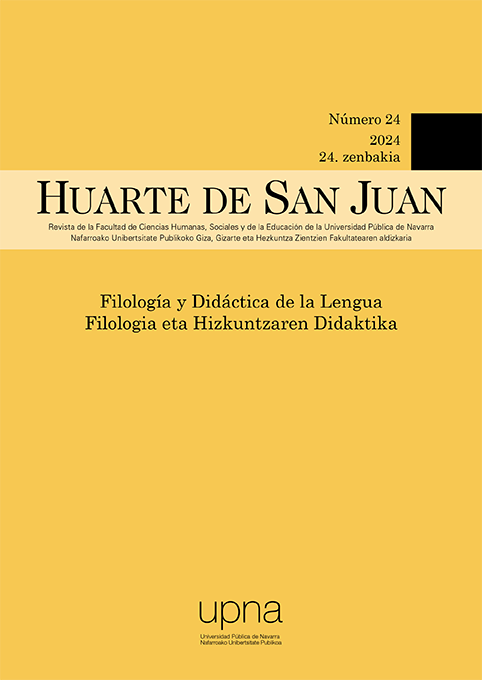The topic of the warrior woman in 'El conde Partinuplés' by Ana Caro de Mallén
DOI:
https://doi.org/10.48035/rhsj-fd.24.1Keywords:
Ana Caro de Mallén, El conde Partinuplés, female characters, warrior woman, Barroque theatreAbstract
In this paper, the paradigms of the warrior woman in the palatine comedy El conde Partinuplés (1653) by Baroque playwright Ana Caro de Mallén (1590-1649) are studied. To do this, it will be essential to review not only the social formation of women in the 17th century, but also the constitution of the model of the warrior woman in the theatre of the time. After that, the study will focus on the construction of the female protagonists of this theatrical piece, women completely opposed to the sociocultural paradigm of the time. In this way, it will be shown that Rosaura and Lisbella are clear references to this literacy topic, who exhibit great strength and independence. Likewise, it can be seen that both distance themselves from the social conventions of women in the 17th century
Downloads
References
Bravo Villasante, C. (1976). La mujer vestida de hombre en el teatro español. Sociedad General Española de Librería.
Burbano Arias, G. (2006). El honor, o la cárcel de las mujeres del siglo XVII. Memoria & Sociedad, 10(21), 17-28.
Caro, R. (2018). Varones insignes en letras naturales de la ilustrísima ciudad de Sevilla. Universidad de Huelva.
Caro de Mallén, A. (1653). El conde Partinuplés. Comedia famosa de doña Ana Caro dezima musa. En D. de Balbuena (Ed.), Laurel de comedias: quarta parte de diferentes autores dirigidas a don Bernardino Blancalana (pp. 135-170). Imprenta Real.
Caro de Mallén, A. (1993). El conde Partinuplés. Edición, introducción y notas de Lola Luna. Reichenberger.
Colón Calderón, I. (2018). Caro de Mallén y Soto, Ana. Diccionario Biográfico Español. Real Academia de la Historia. https://dbe.rah.es/biografias/17213/ana-caro-demallen-y-soto
Domínguez Guzmán, A. (2001). De monjas y poesía de ocasión en la España del seiscientos. En M. J. Porro Herrera (Coord.), Romper el espejo. La mujer y la transgresión de códigos en la literatura española: escritura, lectura, textos. (1001-2000): III Reunión Científica Internacional (Córdoba, diciembre 1999) (pp. 41-50). Universidad de Córdoba.
Escabias, J. (2015). Los locos personajes de Ana Mª Caro Mallén: Rosaura y Aldora de El conde Partinuplés. En M. Martín Clavijo, M. González de Sande, D. Cerrato y E. M. Moreno Lago (Eds.), Locas: escritoras y personajes femeninos cuestionando las normas (pp. 479-493). Arcibel.
Gorlero, M. E. (2020). La soltería femenina: una fuente de sospechas. Revista Movimiento, 24, 23-29.
Lázaro Niso, R. (2020). El motivo de las mujeres guerreras en Cubillo de Aragón. En F. Domínguez Matito, J. M. Escudero Baztán y R. Lázaro Niso (Coords.), Mujer y sociedad en la literatura del Siglo de Oro (pp. 97-112). Iberoamericana Vervuert.
León, fray L. de. (1975). La perfecta casada. Espasa Calpe.
Luna Rodríguez, M. D. (1992). Ana Caro, una escritora profesional del Siglo de Oro. Vida y Obra [Tesis Doctoral, Universidad de Sevilla]. http://hdl.handle.net/11441/41611
Marín Pina, M. C. (1989). Aproximación al tema de la virgo bellatrix en los libros de caballerías españoles. Criticón, 45, 81-94.
McKendrick, M. (1974). Woman and society in the Spanish drama of the Golden Age: A study of the mujer varonil. Cambridge University Press.
Montoussé Vega, J. L. (1994-1995). «Si me buscas, me hallarás». La configuración del discurso femenino en la comedia de Ana Caro El Conde de Partinuples. Archivum: Revista de la Facultad de Filosofía y Letras, 44-45(2), 7-28.
Ordorika, T. (2006). Entre la obediencia y la libertad. Una mujer española del siglo XVII. Revista mexicana de ciencias políticas y sociales, 48(197), 21-33.
Rodríguez Campillo, M. J., Jiménez López, M. D. y Bel Enguix, G. (2011). El disfraz varonil en el teatro español de los Siglos de Oro. Triangle: Language, Literature, Computation, 4, 69-85.
Sánchez Dueñas, B. (2008). De la invisibilidad a la creación. Oralidad, concepción teórica y material preceptivo en la producción literaria femenina hasta el siglo XVIII. Editorial Renacimiento.
Tacón García, A. (2018). «Esclava siendo señora»: Poder y agencia femenina en El conde Partinuplés de Ana Caro de Mallén. Revista de Escritoras Ibéricas, 6, 9-36. https://doi.org/10.5944/rei.vol.6.2018.22075
Tacón García, A. (2019). La inversión de mitos y convenciones literarias en El conde Partinuplés, de Ana Caro de Mallén. En C. Mata Induráin y S. Santa Aguilar (Eds.), «Ars longa». Actas del VIII Congreso Internacional Jóvenes Investigadores Siglo de Oro, JISO 2018 (pp. 405-416). Universidad de Navarra.
Downloads
Published
How to Cite
Issue
Section
License
Copyright (c) 2025 Álvaro Clavijo Corchero

This work is licensed under a Creative Commons Attribution-NonCommercial-NoDerivatives 4.0 International License.
All articles are published under a Creative Commons (BY-NC-ND 4.0) license. Each article will be assigned a DOI.
Authors retain copyright of their work and grant the journal the right to the first publication. Authors can sign additional agreements to non-exclusive distribution of the published version of the article (for example, in an institutional repository) as long as appropriate attribution to the original publication is provided. Articles can be uploaded to institutional repositories immediately after publication.
Electronic distribution of the articles (for example, academic social networks or personal webpages) is allowed and encouraged.
The journal reserves the right to publicise the work in social networks and other electronic means.







